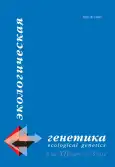Cytogenetic analysis of the residents of North Ossetia living in ecologically different regions
- Authors: Chshiyeva F.T.1
-
Affiliations:
- NOSMA
- Issue: Vol 12, No 3 (2014)
- Pages: 87-94
- Section: Articles
- URL: https://journals.rcsi.science/ecolgenet/article/view/2428
- DOI: https://doi.org/10.17816/ecogen12387-94
- ID: 2428
Cite item
Full Text
Abstract
Keywords
Full Text
##article.viewOnOriginalSite##About the authors
Fatima Taymurazovna Chshiyeva
NOSMA
Email: Fa-2009@yandex.ru
Researcher, Central scientific laboratory
References
- Бочков Н. П. (2003) Экологическая генетика человека. Экологическая генетика. Т. 1: С. 16-21.
- Бочков Н. П., Чеботарев А. Н., Катосова Л. Д. Платонова В. И. (2001) База данных для анализа количественных характеристик частоты хромосомных аберраций в культуре лимфоцитов периферической крови человека. Генетика. Т. 37(4): С. 549-557.
- Бочков Н. П., Дурнев А. Д. (2011) Очевидное и невероятное о представлениях о мутационном процессе у человека. Гигиена и санитария. № 5: С. 9-10.
- Бочков Н. П., Чеботарев А. Н. (1989) Наследственность человека и мутагены внешней среды. М.: Медицина.
- Бочков Н. П. (1974) Метод учета хромосомных повреждений как биологический индикатор влияния факторов внешней среды на человека. М.: Наука.
- Биологический контроль окружающей среды: Генетический мониторинг (2010) Под редакцией С. А. Гераськина и Е. И. Сарапульцевой. М.: Академия.
- Дурнев А. Д. (2008) Методологические аспекты исследований по модификации химического мутагенеза. Бюллетень экспериментальной биологии и медицины. № 9: С. 281-287.
- Дурнев А. Д., Середенин С. Б. (1998) Мутагены - скрининг и фармакологическая профилактика воздействий. М.: Медицина.
- Дурнев А. Д., Соломина А. С., Жанатаев А. К. с соавт. (2010) Влияние афобазола на генотоксические эффекты табачного дыма в плаценте и в тканях эмбрионов крыс. Бюллетень экспериментальной биологии и медицины. № 3: С. 286-289.
- Дружинин В. Г. (2003) Количественные характеристики частоты хромосомных аберраций в группе жителей крупного промышленного региона Западной Сибири. Генетика. Т. 39(10): С. 1373-1380.
- Зенгелиди В. В. (2009) Влияние техногенного загрязнения на состояние почв г. Владикавказа: Дисс… канд. биол. наук. Владикавказ.
- Скупневский С. В. (2006) Анализ состояния биоресурсов в условиях антропогенного загрязнения окружающей среды с использованием крыс в качестве тест-системы: Автореф. дисс… канд. биол. наук. Владикавказ.
- Менчинская О. В. (2004) Эколого-геохимические аспекты техногенного загрязнения металлургических центров (на примере Владикавказа): Дисс… канд. геол.-минерал. наук. М.
- Минина В. И., Дружинин В. Г., Глушков А. Н. с соавт. (2009) Количественные характеристики частоты хромосомных аберраций у жителей районов с различным уровнем онкологической заболеваемости. Генетика. Т. 45(2): С. 239-246.
- Ревич Б. А. (2007) «Горячие точки» химического загрязнения окружающей среды и здоровье населения России/под редакцией В. М. Захарова. М.: Акрополь, Общественная палата РФ.
- Рупошев А. Р. (1976) Цитогенетический эффект ионов тяжелых металлов на семена Crepis capillaries L. Генетика. Т. 12(3): С. 37-43.
- Рупошев А. Р., Гарина К. П. (1976) Мутагенное действие солей кадмия. Цитология и генетика. Т. 10(5): С. 32-36.
- Шредер О. В., Смольникова Н. М., Дурнев А. Д., Середенин С. В. (2008) Влияние афобазола на тератогенные эффекты циклофосфамида у крыс. Бюл. экспериментальной биологии и медицины. № 4: С. 414-417.
- Чопикашвили Л. В., Бобылева Л. А., Золоторева Г. Н. (1989) Генотоксические эффекты тяжелых металлов и их солей в эксперименте на дрозофиле и млекопитающих. Цитология и генетика. № 3: С. 35-38.
- Battershill J. M., Burnett K. and Bull S. (2008) Factors affecting the incidence of genotoxicity biomarkers in peripheral blood lymphocytes: impact on design of biomonitoring studies. Mutagenesis. Р. 1-15.
- Boffetta P. and Nyberg F. (2003) Contribution of environmental factors to cancer risk. British Medical Bulletin. V. 68: P. 71-94.
- Coelhoa P., Garcнa-Lestуnb J., Costaa S. et al. (2013) Genotoxic effect of exposure to metal (loid)s. A molecular epidemiology survey of populations living and working in Panasqueira mine area, Portugal. Environment International. V. 60: P. 163-170.
- Chervona Y., Arita A., Costa M. (2012) Carcinogenic Metals and the Epigenome: Understanding the effect of Nickel, Arsenic, and Chromium. Metallomics.Vol. 4(7). P. 619-627.
- Hagmar L., Stromberg U., Bonassi S. (2004) Impact of Types of Lymphocyte Chromosomal Aberrations on Human Cancer Risk. Results from Nordic and Italian Cohorts. Cancer Research. V. 64: P. 2258-2263.
- Salnikow K., Zhitkovich A. (2008) Genetic and Epigenetic Mechanisms in Metal Carcinogenesis and Cocarcinogenesis: Nickel, Arsenic and Chromium. Chem. Res. Toxicol. V. 21(1). P. 28-44.
- Sram R. J., Beskida O., Binkova B., Chvatalova I. (2007) Chromosomal aberrations in environmentally exposed population in relation to metabolic and DNA repair genes polymorphisms. Mutation Research. V. 620: P. 22-33.
- Sram R. J., Rossner P., Smerhovsky Z. (2004) Cytogenetic analysis and occupational health in the Czech Republic. Mutation Research. V. 566: P. 21-48.
- Merlo D. F., Ceppi M., Stagi E. et al. (2007) Baseline chromosome aberrations in children. Toxicol Lett. V. 30. P. 60-67.
- Norppa H., Bonassi S., Hansteen I. L. et al. (2006) Chromosomal aberrations and SCEs as biomarkers of cancer risk. Mutation Research. V. 600: P. 37-45.
- Vodicka P., Polivkova Z., Sytarova S. et al. (2010) Chromosomal damage in peripheral blood lymphocytes of newly diagnosed cancer patients and healthy controls. Carcinogenesis. Vol. 31(7): P. 1238-1241.
Supplementary files






